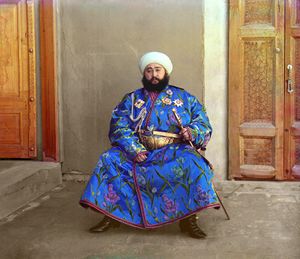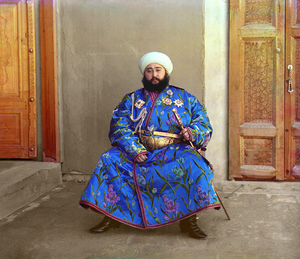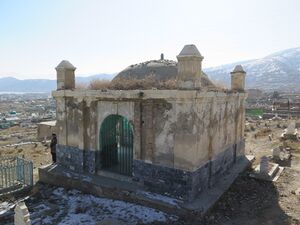محمد عالم خان
| عالم خان | |
|---|---|
 صورة محمد عالم خان (1880 - 1944)، آخر أمراء بخارى، التقطها عام 1911 سرگي پروكودين-گورسكي، وملونة في مكتبة الكونجرس. | |
| أمير بخارى | |
| العهد | 3 يناير 1911 – 30 أغسطس 1920 |
| سبقه | عبد الأحد خان |
| تبعه | ملكية ألغاها غزو الجيش الأحمر. الأراضي استولى عليها الاتحاد السوڤيتي |
| وُلِد | 3 يناير 1880 بخارى، إمارة بخارى (أوزبكستان الحالية) |
| توفي | 28 أبريل 1944 (aged 64) كابول، أفغانستان |
| البيت | أسرة منگود |
| الأب | عبد الأحد خان |
| الديانة | الإسلام |
السيد مير محمد عالم خان (3 يناير 1880-28 أبريل 1944) هو آخر أمراء أسرة منگيت،[1] التي كانت آخر الأسر الحاكمة لإمارة بخارى في آسيا الوسطى. وبالرغم من أن بخارى كانت محمية للإمبراطورية الروسية منذ عام 1873 ، إلا أنه كان يسيّر الشؤون الداخلية للإمارة كعاهل مطلق، وحكم من 3 يناير 1911 إلى 30 أغسطس 1920. ويفترض أنه أحد أحفاد جنگيز خان، أول خان أعظم.
السيرة
في الثالثة عشرة من عمر عالم خان بعثه والده الأمير عبد الأحد خان إلى سانت بطرسبورگ لدراسة فن الحكم والتقنيات العسكرية الحديثة لمدة ثلاث سنوات. وفي عام 1896 ، بعد أن أخذ موافقة رسمية من الحكومة الروسية لتعيينه ولياً لعهد إمارة بخارى، عاد إلى الوطن.
بقي سنتين في بخارى يساعد والده في إدارة الحكم ، ثم عين حاكما لمنطقة نسف لمدة اثني عشر عاماً. ليتم نقله إلى شمال مقاطعة قرمينه، التي حكمها لسنتين أخريين، حتى تلقى نبأ وفاة والده في عام 1910.
عهده
بدأ عالم خان عهده واعداً. ففي البداية أعلن أنه لن يتوقع أو يقبل بعد ذلك التاريخ الهدايا وحظر على مسئوليه طلب الرشوة من العامة أو فرض رسوم بدون تفويض. ولكن مع مرور الوقت بدأ مواقفه من الرشاوي وفرض الضرائب ورواتب الدولة تتغير. . فالصراع بين الاصلاحيين والتقليديين انتهي بفوز التيار التقليدي وسيطرته على مقاليد الحكم، وتم نفي الاصلاحيين إلى موسكو أو كازان. ومن المعتقد أن عالم خان، الذي اختار في البداية التحديث مع الإصلاحيين ، أدرك أنه في نهاية مطاف التحديث لن يكون هناك مكان لمنصبه ولا لأولاده. فقد كان كأسلافه حاكماً تقليدياً. وقد لعب بفكرة الإصلاح ردحاً من الزمان للسيطرة على رجال الدين، طالما لم تهدد حكم أسرة منگيت.
أحد أهم الكتاب الطاجك عيني صدر الدين، كتب صوراً حية عن الحياة في عهد الأمير. ثم تعرض للجلد للتحدث بالطاجيكية. وبعد ذلك كتب عن الحياة في ظل الأمراء في "جلادو بخارى".
عالم خان الحاكم الوحيد أضاف لقب الخليفة لاسمه ، وكان آخر أبناء جنكيز خان .
في مارس 1918 أبلغ الناشطون في حركة الشباب البخاري البلاشفة أن أهل بخارى جاهزين للثورة، وأن الناس يتوقون للتحرر. الجيش الاحمر سار إلى بوابات بخارى وطالب الامير تسليم المدينة إلى البخاريين الشباب. كما ذكرت مصادر روسية في التقرير. رد الأمير بقتل الوفد البلشڤي، إلى جانب عدة مئات من الروس المؤيدين للبولشفيين سكان بخارى والأراضي المحيطة بها. غالبية البخاريين لم يؤيدوا الغزو والقوات الغازية البلشفية كان ينقصها التجهيز والانضباط. لذا فقد انسحبت القوات الغازية إلى المعقل السوڤيتي في طشقند.
الإطاحة والموت
ولكن الامير لم يفز سوى بهدنة مؤقتة. حيث الحرب الأهلية في روسيا خفت حدتها، وأرسلت موسكو تعزيزات إلى وسط آسيا. وفي 2 سبتمبر 1920، أرسل الجيش الأحمر قوة حسنة الانضباط ومجهزة تجهيزاً جيداً تحت قيادة الجنرال البلشفي ميخائيل فرونزه لتهاجم المدينة. بعد أربعة أيام من القتال، تم تدمير قلعة الأمير ورفع العلم الأحمر من أعلى مئذنة كاليان، واضطر الأمير عالم خان إلى الفرار إلى قاعدته في دوشانبه (في طاجيكستان الحالية)، وأخيرا إلى كابول، أفغانستان.
وتوفي في كابول في عام 1944.
العائلة

Although the emir had several children, the exact number of offspring the emir had is unknown. Emir Alim Khan had three official wives in Bukhara but after settling in Afghanistan, people there sympathized with him and many gave their daughters to him as wives. Therefore, he had several more wives in Afghanistan.[2]
Seyid Alim Khan had numerous offspring, which according to some estimates is about 500 people. During the last years of the Emir's life, almost all of his descendants were with him, with the exception of a few people. Due to the fact that by the end of August 1920 the Red Army was rapidly surrounding and began to bombard and storm Bukhara, Seyid Alim Khan hastily began to evacuate himself, his family and some of his close associates. However, possibly due to the suddenness of the forced evacuation, his three young sons—about 8–10 years old (according to other sources, 4–6 years old), Sultanmurad, Shahmurad and Rakhimkhan—remained in Bukhara. After the capture of Bukhara, the Bolsheviks discovered them and at first wanted to shoot them together with the remaining several members of the family and close associates of the emir (similar to the execution of Nicholas II with his family and close associates), but left them alive in order to further propaganda in their favor, sending all three to Moscow, to be raised in an orphanage for orphans of dead Bolsheviks and soldiers of the Red Army.
Seyid Alim Khan appealed to the Bolsheviks and the world community to let his children and other family members who remained in Bukhara be released to join him in Afghanistan. But the Bolsheviks refused him and in fact kept them as a hostage for personal political and ideological purposes. The eldest of the three sons of Seyid Alim Khan remaining in the USSR, Sultanmurad, was disabled and lame from birth. He graduated from the Faculty of Workers and after his studies began working at a factory for the disabled. According to some reports, he spoke English. Some time later, Sultanmurad was arrested by the NKVD and declared an " enemy of the people ". Among other charges, he was accused of collaborating with British intelligence. After his arrest, Sultanmurad announced a hunger strike and soon died, most likely from exhaustion. Sultanmurad was married. His wife at that time worked at a soap factory and, according to some reports, upon learning of the death of her husband, she threw herself into a cauldron of boiling soap.
Before the outbreak of World War II, during the "Great Terror", the youngest of the remaining sons of Seyid Alim Khan, Rakhimkhan, who remained in the USSR, tried to flee the country, but he was detained by Soviet border guards right on the Soviet-Afghan border. According to some sources, he was detained on the territory of the Uzbek SSR, right on the Amu Darya River, which separated the USSR and Afghanistan; according to other sources, he was detained on the territory of the Turkmen SSR, where the border between the USSR and Afghanistan runs through the steppes and hills. After that, a sentence of execution was read to him, and he was shot by the NKVD.

The middle of the three, Shakhmurad, was also with his brothers in a Moscow orphanage, but in 1922, together with several Bukhara youths, he was sent by the authorities of the Bukhara People's Soviet Republic to study in Germany as part of the training of new young personnel for the young republic. Due to ideological considerations, he was given a new full name - "Alimov Shah Muratovich" (according to other sources, his full name was "Shakhmurad Alimkhanov"). After returning from studies, he was fluent in German. He also studied at the Institute of the coal industry. According to Shakhmurad's classmate, Khaidar Yusupov, Shakhmurad dreamed of becoming a military man, but he could not be admitted to study at a military school due to ideological considerations, since he was "the son of an enemy of the people." After that, on the advice of friends and acquaintances, he decided to disown his father. In 1930 (according to other sources, in 1929) he wrote an open letter to his father through the Izvestia newspaper, where he renounced Seyid Alim Khan, accusing him and his government of grave sins and deeds. According to some reports, this was arranged by the NKVD, which pushed him to take such a step through acquaintances and friends who were informers of this special service. After that, he was admitted in the Moscow Military Engineering Academy named after V. V. Kuibyshev. After graduation, he began teaching at the same academy. He served in the Red Army and later received the rank of major general. He participated in the Great Patriotic War (World War II) and lost his leg, was awarded the Order of the Red Banner, and after the end of the war he again began teaching at the V. V. Kuibyshev Military Engineering Academy in Moscow. He was married, his wife's name was Lidia Mikhailovna. According to the memoirs of one of Shakhmurad's contemporaries, "When Shakhmurad came to visit us with his wife Lidia Mikhailovna, then, having drunk, he remembered his parents and cried." Many of Shahmurad's acquaintances and friends did not know about his origin, and he spoke about his past only to close friends. According to some reports, he died in 1985 in Moscow, at the age of 75.[3]
Alim Khan's daughter, Shukria Alimi Raad, worked as a broadcaster for Radio Afghanistan. Shukria Raad left Afghanistan with her family three months after Soviet troops invaded the country in December 1979. With her husband, also a journalist, and two children she fled to Pakistan, and then through Germany to the United States. In 1982 she joined the Voice of America, working for many years as a broadcaster for VOA's Dari Service, editor, program host and producer.[4]
During his governance in Bukhara, Alim Khan also had a son named Qasem who was killed by the Bolshevik revolutionaries. Qasem had only one son who, when he was 13 years old, escaped from Bukhara to Mashad, Iran with his stepfather. When he arrived in Iran, he took the name Husein Bukharaei. He married Bibimeymanat Mohsenolhoseini in Mashhad. They had 6 sons and 4 daughters. Husein Bukharaei died in 1993. Their children (Hasan, Lo'ba, Ali, Narges, Qasem, Reza, Fatemeh, Mohammad, Mahmoud, Mahboubeh) all live in Mashhad.
In 2020, the BBC World Service made a documentary called Bukhara about the last ruler of Bukhara, which refers to the fate of the family of Amir Alam Khan.
Alim Khan's descendants include granddaughter Nailaj Naebzadeh from his daughter Razia Alimi, and great-granddaughter Kadeij Naebzadeh.[2] They live in United States. Nailaj Naebzadeh was born in United States. Just like her aunt, Shukria Alimi Raad, her mother Razia Alimi also escaped from Afghanistan during the invasion of the Soviet Army in 1979.[2]
الهامش
- ^ ЭСБЕ/Манкытская династия — Викитека
- ^ أ ب ت "Homecoming Exclusive Interview with the Descendants of the Last Emir of Bukhara". The Mag. 2 October 2019.
- ^ Litvak, Dmitriy; Kuznetzov, Alexander. "The Last Emir of Noble Bukhara and His Money." International Bank Note Society Journal, vol.50-3
- ^ "A Princess-Broadcaster". Voice of America. 31 March 2002.
| ألقاب ملكية | ||
|---|---|---|
| سبقه عبد الأحد خان |
أمير بخارى 1911–1920 |
الملكية ألغيت |
- Short description is different from Wikidata
- مواليد 1880
- وفيات 1944
- تاريخ أوزبكستان
- Emirs of Bukhara
- Ethnic Uzbek people
- Russian anti-communists
- أشخاص من بخارى
- بورجيگين
- Recipients of the Order of Saint Stanislaus (Russian), 1st class
- Recipients of the Order of St. Vladimir, 2nd class
- Recipients of the Order of St. Anna, 1st class
- Recipients of the Order of the White Eagle (Russia)
- Recipients of the Order of St. Alexander Nevsky
